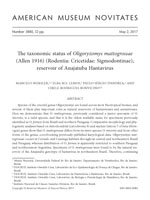Species of the cricetid genus Oligoryzomys are found across most Neotropical biomes, and several of them play important roles as natural reservoirs of hantaviruses and arenaviruses. Here we demonstrate that O. mattogrossae, previously considered a junior synonym of O. microtis, is a valid species, and that it is the oldest available name for specimens previously identified as O. fornesi from Brazil and northern Paraguay. Comparative morphology and phylogenetic analyses based on mitochondrial (cytochrome b) and nuclear (intron 7 of beta-fibrinogen) genes show that O. mattogrossae differs from its sister species O. microtis and from other forms of the genus, corroborating previously published karyological data. Oligoryzomys mattogrossae occurs in Cerrado and Caatinga habitats throughout central and northeastern Brazil and Paraguay, whereas distribution of O. fornesi is apparently restricted to southern Paraguay and northernmost Argentina. Specimens of O. mattogrossae were found to be the natural reservoir of the Anajatuba genotype of hantavirus in northeastern Brazil. Therefore, continuing efforts to delimit Oligoryzomys species and facilitate their identification are important for zoonotic monitoring.
How to translate text using browser tools
2 May 2017
The Taxonomic Status of Oligoryzomys mattogrossae (Allen 1916) (Rodentia: Cricetidae: Sigmodontinae), Reservoir of Anajatuba Hantavirus
Marcelo Weksler,
Elba M.S. Lemos,
Paulo Sérgio D'Andrea,
Cibele Rodrigues Bonvicino





